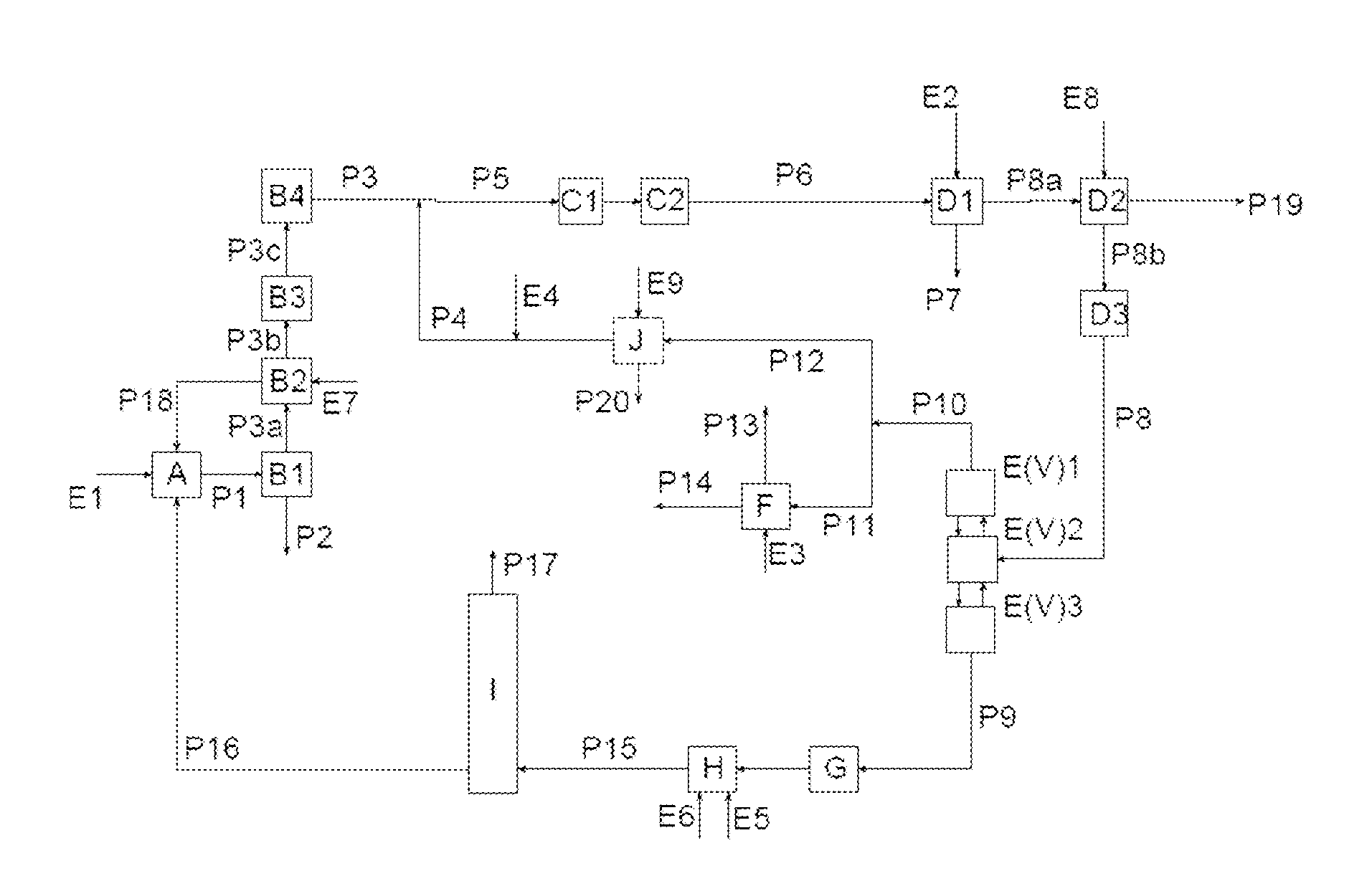Method for producing isocyanates
A technology of isocyanate and product flow, which is applied in the preparation of isocyanic acid derivatives, purification/separation of isocyanic acid derivatives, and preparation of chlorides, etc., which can solve the problems of increased demand for sodium hydroxide solution and high cost
- Summary
- Abstract
- Description
- Claims
- Application Information
AI Technical Summary
Problems solved by technology
Method used
Image
Examples
Embodiment 1
[0125] Example 1 (according to the invention)
[0126] figure 2 It is the basis of simulation.
[0127] By means of stream P16, phosgene in excess of 100% compared to the stoichiometric amount of the primary amine toluene diamine (TDA) contained in stream E1 is fed to reactor A. The reaction for the production of toluene diisocyanate (TDI) was carried out at 150°C and a pressure of 2.6 bar. Most of the unreacted phosgene is taken out as stream P1 together with solvent (o-dichlorobenzene, ODB), TDI and by-product HCl, and cooled to 35°C in B1. The product TDI is withdrawn from B1 in liquid form together with stream P2, and HCl, phosgene and other components leave section B1 in gaseous form with stream P3a. P3a is in contact with stream E7 containing fresh ODB in absorber section B2. In this process, most of the phosgene contained in P3a is absorbed. HCl leaves the absorber in gaseous form together with stream P3b. Among other things, P3b still contains approximately 0.23vol% p...
Embodiment 2
[0134] Example 2 (according to the invention)
[0135] image 3 It is the basis of simulation.
[0136] Example 2 includes the same steps as Example 1, but an additional part of HCl gas is transferred from the absorber B2 and directed to the HCl absorber (not shown). A part of the stream leaving the condensation step I in gaseous form and containing excess CO is further recycled to the reactor H.
[0137] Segments A, B1 and B2 operate as described in Example 1. HCl leaves the absorber in gaseous form together with stream P3b. Among other things, P3b still contains about 0.24vol% of phosgene and about 1.2vol% of N 2 And trace amounts of solvent ODB, etc., where N 2 From the process used to inertize or maintain pressure. However, its CO 2 The content is 1.5 vol%, which is now significantly higher than that of Example 1, because the amount of flushing out of it by returning the material in the condensation step I1 / I2 is less and therefore aggregation occurs. On the other hand, there...
Embodiment 3
[0143] Example 3 (comparative example)
[0144] Figure 4 It is the basis of simulation.
[0145] Example 3 contains the same steps as Example 1, but E is now configured as a distillation column, the purpose is to avoid CO 2 The liquid chlorine and dissolved oxygen are removed from it.
[0146] Segments A, B1, B2, B3, and B4 operate as described in Example 1. HCl leaves absorber B2 in gaseous form together with stream P3b. P3b still contains about 0.22vol% of phosgene and about 1.2vol% of N 2 And trace amount of solvent ODB, etc., where N 2 From the process used to inertize or maintain pressure. Its CO 2 And CO content 0.15vol% (CO 2 ) And 0.03vol% (CO) are much lower than in Example 1, which is due to the distillation of liquid chlorine, which is basically no CO 2 It is sent to step H of phosgene preparation together with stream P9 without oxygen.
[0147] The gas stream P3b is compressed to 6 bar in the compressor B3 and introduced into the purification section B4 as a stream P3c....
PUM
| Property | Measurement | Unit |
|---|---|---|
| purity | aaaaa | aaaaa |
Abstract
Description
Claims
Application Information
 Login to View More
Login to View More - R&D
- Intellectual Property
- Life Sciences
- Materials
- Tech Scout
- Unparalleled Data Quality
- Higher Quality Content
- 60% Fewer Hallucinations
Browse by: Latest US Patents, China's latest patents, Technical Efficacy Thesaurus, Application Domain, Technology Topic, Popular Technical Reports.
© 2025 PatSnap. All rights reserved.Legal|Privacy policy|Modern Slavery Act Transparency Statement|Sitemap|About US| Contact US: help@patsnap.com



